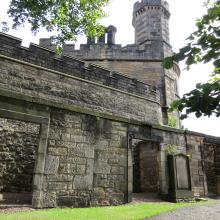
The following extract is from ‘Old Mortality’, Chapter 3 in Robert Louis Stevenson’s Memories and Portraits: a collection of essays first published together in 1887.
In it Stevenson recalls time spent during his student days in the 1870s in Old Calton Burying Ground.
The cemetery was first opened in 1718 and extended in 1767, but in 1819 it was bisected by Waterloo Place (engineered by RLS’s grandfather) and many remains were transposed to the New Calton Burying Ground further east. The oldest headstone – that of Thomas Robertson, cordner – lies in the rump cemetery beside the Parliament House Hotel on Calton Hill.
The Stevenson extract begins here:
There is a certain graveyard, looked upon on the one side by a prison, on the other by the windows of a quiet hotel; below, under a steep cliff, it beholds the traffic of many lines of rail, and the scream of the engine and the shock of meeting buffers mount to it all day long.

The aisles are lined with the inclosed sepulchres of families, door beyond door, like houses in a street; and in the morning the shadow of the prison turrets, and of many tall memorials, fall upon the graves.
There, in the hot fits of youth, I came to be unhappy. Pleasant incidents are woven with my memory of the place. I here made friends with a certain plain old gentleman, a visitor on sunny mornings, gravely cheerful, who, with one eye upon the place that awaited him, chirped about his youth like winter sparrows; a beautiful housemaid of the hotel once, for some days together, dumbly flirted with me from a window and kept my wild heart flying and once—she possibly remembers—the wise Eugenia followed me into that austere inclosure.

Her hair came down, and in the shelter of the tomb my trembling fingers helped her to repair the braid.
But for the most part I went there solitary and, with irrevocable emotion, pored on the names of the forgotten. Name after name, and to each the conventional attributions and the idle dates: a regiment of the unknown that had been the joy of mothers, and had thrilled with the illusions of youth, and at last, in the dim sickroom, wrestled with the pangs of old mortality.
In that whole crew of the silenced there was but one of whom my fancy had received a picture; and he, with comely florid countenance, bewigged and habited in scarlet, and in his day combining fame and popularity, stood forth, like a taunt, among that company of phantom appelations. It was then possible to leave behind us something more explicit than these severe, monotonous and lying epitaphs; and the thing left, the memory of a painted picture and what we call the immortality of a name, was hardly more desirable than mere oblivion.
Even David Hume, as he lay composed beneath that ‘circular idea,’ was fainter than a dream; and when the housemaid, broom in hand, smiled and beckoned from the open window, the fame of that bewigged philosopher melted like a raindrop in the sea.

1. The engraving above is a detail of J. Sulman's supplement to the London Illustrated News of July 1868.
2. No correlation between the actions of anyone appearing in the photographs above and historical figures mentioned in the extract is implied or intended.
----------------------------------
Robert Louis Stevenson, death, sex, trembling. What more do you want? http://www.broughtonspurtle.org.uk/news/old-mortality-and-wise-eugenia … @RLSMuseum #Festival2014
@theSpurtle @RLSMuseum Death, sex and trembling, but not necessarily in that order?
Broughton Spurtle @theSpurtle
@PeatWorrier @RLSMuseum (1)Trembling. (2) Sex. (3) More trembling. (4) Petite mort. (5) Tremendous guilt. (6) Tremens. (7) Death. Happy noo?
PeatWorrier @PeatWorrier
@theSpurtle @RLSMuseum A mixture of happiness and shame.
Broughton Spurtle @theSpurtle
@PeatWorrier @RLSMuseum That cognitive dissonance was not unusual in 19th-century Embo cemeteries. Female mourners required no chaperones.
@theSpurtle @RLSMuseum Oh my. *fans self, lets out girdle*